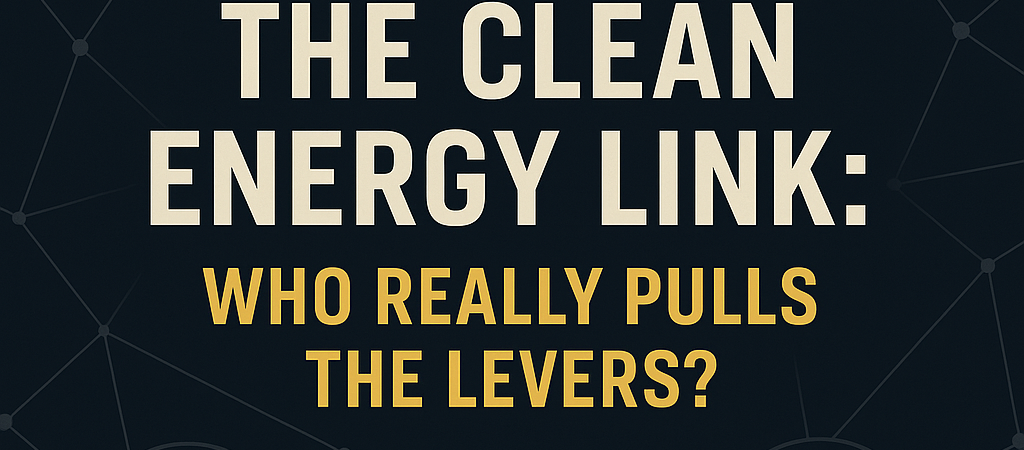Western Australia’s Clean Energy Link is sold as a bold step toward decarbonisation. But scratch the surface, and it starts to look more like a well-rehearsed script — one where the costs are socialised, the risks are absorbed by the public, and the profits are captured quietly by a web of actors who never seem to lose.
The Setup: What Is the Clean Energy Link?
The Clean Energy Link is a major transmission infrastructure initiative designed to unlock remote renewable energy zones (REZs) and support the state’s Net Zero ambitions. It’s pitched as a way to connect proposed wind and solar projects in the Mid West and Great Southern to the South West Interconnected System (SWIS).But it’s not connecting existing generation. It’s being built for proposed generation — largely by private developers, who will benefit from government-funded grid access without footing the bill.
How It’s Being Framed
Words like sustainability, resilience, and transition coat the project in moral legitimacy. It’s not just an infrastructure project — it’s a “vision” for a cleaner future.But while the public is asked to believe in the mission, behind the scenes the machine is humming:
- Transmission upgrades funded by regulated network charges.
- Renewable developers locking in land access and then waiting for public investment to lift the value of their assets.
- Consulting firms writing both the policy and the business case.
It’s a familiar model: socialise risk, privatise reward.
The Monetisation of Dormant Assets
This is the real game: turning unmonetised public assets (like land, transmission corridors, or regulatory frameworks) into private opportunity.Here’s the process:
- Identify a dormant asset — land, data, grid capacity, etc.
- Wrap it in a compelling narrative — clean energy, climate, jobs.
- Secure government funding or reform — often through advisory reports written by the same firms that later win tenders.
- Privatise the monetisation — through exclusive access, long-term contracts, or asset flipping.
- Keep the public out of the conversation — because by the time it’s announced, it’s already decided.
Who’s Pulling the Levers?
State-Level:
- Western Power (state-owned) builds the transmission.
- Energy Policy WA sets the policy agenda.
- Synergy (also state-owned) participates as a generator and retailer.
- The ERA signs off on access arrangements that bake these costs into your power bill.
Private Sector:
- Renewable energy developers (backed by global capital) wait patiently for connection.
- Macquarie, IFM, Brookfield, etc., package and sell the projects.
- Engineering firms and consultants write the policy, design the network, and deliver the projects.
NGOs and Think Tanks:
- Help shape the public narrative, legitimising centralised energy control.
- Use moral framing — “just transition,” “climate equity” — to push structural reform.
Regulatory Theatre:
- Pretend oversight, no actual disruption.
- Everyone signs off on what the model says is the “least-cost path.”
Above That: The Invisible Hand
Here’s where it gets real.This entire framework is shaped by an invisible architecture of:
- Global finance: ESG mandates, green bonds, sustainability-linked loans.
- Supranational governance: UN SDGs, WEF playbooks, Net Zero by 2050.
- Consulting & Modelling: EY, McKinsey, IEA produce the scenarios everyone else blindly follows.
- Digital governance: smart meters, programmable tariffs, grid-interactive appliances.
WA isn’t immune. It’s an ideal testbed:
- Remote enough to avoid scrutiny.
- Rich enough in resources to justify investment.
- Politically docile enough to roll it out without protest.
And Above That?
This is where we reach the meta-layer — the operating system, not the app.The global transition is steered by dynastic foundations, intergenerational wealth networks, and idea-shaping institutions:
- Rockefeller, Ford, Soros foundations.
- Rhodes Trust, Club of Rome.
- Media conglomerates, think tanks, universities.
They don’t own the assets — they own the narrative, the language, the metrics of legitimacy.This is not a conspiracy. It’s consensus. It’s institutional design.And you only see it when you stop asking “who approved this project?” and start asking “who benefits when the world is managed this way?”
Why No One at Western Power Sees It
They do — some of them. Quietly. But most:
- Are career-aligned to the narrative.
- Genuinely believe they are helping.
- Are too polite, too overworked, or too disempowered to dissent.
- Don’t want to risk being “non-collaborative.”
So the wheels keep turning.
Final Thought
This isn’t just a grid upgrade. It’s the local expression of a global operating system, where capital flows dictate policy, compliance masquerades as progress, and all resistance is either marginalised or monetised.It’s not clean. It’s not democratic. But it is working — for the people who designed it.And until more people start asking the questions you just did, it will keep working against everyone else.






